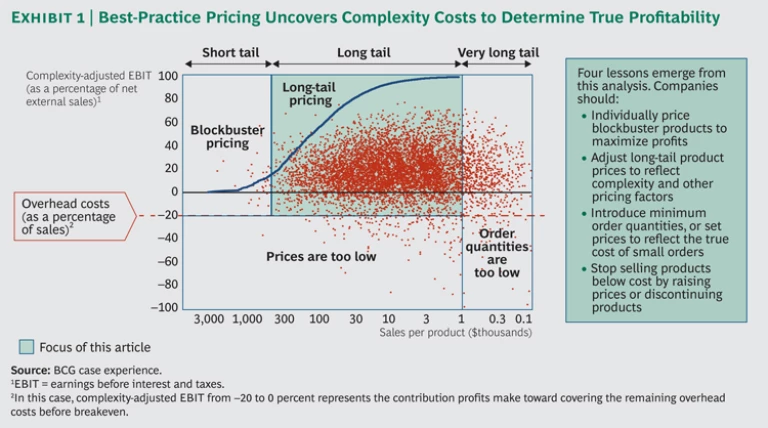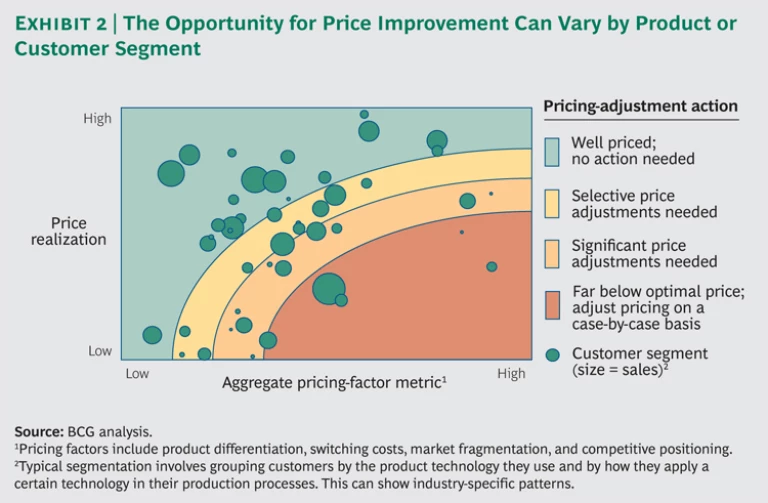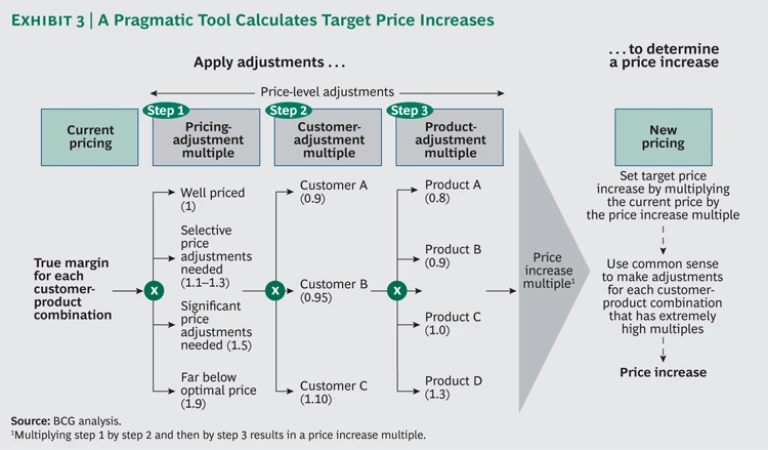Effectively pricing products can be a balancing act. For companies in business-to-business markets with sometimes thousands of products, it is a particularly complex challenge. As a result, these companies tend to actively manage the pricing of only key products on the basis of value delivered to customers and competitors’ prices, reserving simple cost-plus approaches for the rest. They largely neglect active pricing for the vast majority of products in the “long tail.”
When many managers think of the long tail, they often picture an online retailer that sells a vast selection of products to consumers thanks to its nearly limitless shelf space. However, long tails are common in many business-to-business companies. They frequently customize and repackage offerings that can be sold to only an extremely small number of customers, producing thousands of SKUs. As a result, these companies often follow a one-size-fits-all pricing strategy—what we call the 20-80-50 formula: 20 percent of an organization’s products receive 80 percent of the attention from sales and management while accounting for only 50 percent of the company’s profits. The approach is not surprising; it makes good sense to devote sizable resources to the highest-selling products.
Nevertheless, the 20-80-50 formula means 80 percent of the company’s products are undermanaged, even though they account for the remaining 50 percent of profits. These products represent little revenue individually but significant margin upside collectively. If they were managed better, they could generate meaningful results.
Companies undermanage the long tail because they lack transparency into the true costs of complex products and because they find it too time consuming or expensive to use sophisticated pricing tools such as choice-based modeling, value estimates, customer value-perception surveys, and competitor value maps. However, by not actively managing long-tail pricing, companies miss out on opportunities to capture the full value potential of their product portfolio.
The Boston Consulting Group has developed an approach to long-tail pricing that addresses these challenges. It is a way for organizations to seek out and calculate the costs of complexity that matter, assess pricing on the basis of the value delivered and product differentiation, and ensure a robust implementation of a new pricing approach. Our view is that long-tail pricing does not have to be daunting.
A specialty chemicals company, for example, systematically addressed the long tail of more than 15,000 products, delivering a margin increase of 10 percentage points and a market share increase of 3 to 5 percentage points. Another industrial-goods company repriced 20,000 products and options, which translated into a margin increase of 5 percentage points and a rise in market share of 2 percentage points. Many other leading business-to-business organizations have experienced similar breakthrough results when they have taken the necessary steps to implement this approach.
In this article, we explain how to execute a strategy for effective long-tail pricing. This well-tested approach makes it possible to tailor the pricing of products to specific product and customer segments and achieve winning results.
Seek Out Cost Transparency
The first step in pricing long-tail products focuses on uncovering their true profitability.
Individual customers with unique needs that require tailored solutions are frequently the source of the long product tail. To price these offerings properly, best practices dictate discovering all costs—the direct costs of producing and selling the products, as well as the complexity costs involved in customization. Such transparency is central to making the right pricing decisions.
For example, companies often treat the costs of redesigning products for individual customers as indirect or overhead costs. In doing so, companies use a percentage of sales to allocate these complexity costs across all products rather than apply the costs, as they do direct costs, to individual products. Such standard cost-allocation models can overstate the profitability of long-tail products. Only when organizations take into account complexity costs can they determine if the prices of long-tail products contribute enough profit toward covering the remaining overhead costs. (See Exhibit 1.) If they don’t, companies should adjust the pricing of their products and set price and order-quantity minimums. Alternatively, companies could decide that they are better off not selling the products at all.
Becoming aware of true product costs also helps managers gain a thorough understanding of the complexity in an organization’s value chain. Consider the case of a small-parts manufacturer that receives a special order beyond the scope of the standard components that the company already produces. This custom adaptation requires a significant amount of extra work, including the engineering of the product, a dialogue with the customer to be sure the team is proceeding correctly, and the creation and stocking of the new article along with the appropriate documentation. Insight into these processes shows managers the avenues that can reduce overall complexity. It also helps them weigh the costs of increased complexity against, for example, the costs of downtime in the assembly line process.
Base Pricing on the Value Proposition
The second step in long-tail pricing is for companies to understand how they create value for customers. This can depend on multiple factors related to products, services, and competition. As a result, customers’ willingness to pay a certain price can vary widely across segments. Leaders need to understand these variations and align their prices accordingly. To do so effectively requires a thorough and pragmatic analysis of pricing factors. (See Exhibit 2.)
To price well across segments, executives should ask the following questions:
How unique or differentiated are our product offerings in the marketplace?
How important are our products to customers, and how price sensitive are these customers? What are the costs of switching to another company’s product?
How intense is the competition? How many alternatives does a customer have?
How much pricing leeway do we have in each segment on the basis of our competitive positioning? Are we a market leader or follower?
By using a pragmatic scoring framework with readily available input from the marketing, sales, and R&D teams, leaders can answer these questions precisely and bring rigor to the analysis in short order. When organizations have a firm understanding of their value proposition and a strong sense of their pricing flexibility across segments, then they can begin to take action.
To make long-tail pricing a more realistic undertaking, we have designed a tool that calculates specific pricing increases for each customer-product combination across a company’s long tail. (See Exhibit 3.) By inputting the pricing-adjustment multiple for each customer-product combination, a company can use this algorithm to reprice thousands of products. This way, a painstaking manual adjustment of prices for each customer-product combination becomes unnecessary. In addition, once the tool has been set up, it can provide guidance for future long-tail pricing decisions. It enables the sales team to price correctly right from the start.
To adjust for outliers and overly steep increases, we suggest sales teams stay flexible and apply sound business judgment. Quadrupling the price of an insignificant item might minutely increase profits, but it would rarely be worth doing. In such cases, it is usually more fruitful to incorporate into long-tail pricing surcharges or fees (for requesting 24-hour delivery or technical support, for example) and policies (for ordering minimum quantities, for instance). These can have a greater impact on the bottom line while still gaining customer acceptance. Unlike pricing and discounts, surcharges, fees, and policies are often not part of the sales negotiation process.
Addressing such aspects cannot be thought of as a one-time exercise, however. It is essential to put in place a robust and recurring process that evaluates them. Having such an ongoing exercise will point out which products are undermanaged and in the red, as well as how much room there is to raise prices.
Set Up a War Room to Ensure Robust Implementation
The third step in long-tail pricing is implementation—an essential element of success. The key to execution involves tracking and analyzing real-time data about pricing and customers’ and competitors’ actions so as to make adjustments and take counteractions quickly.
Effective companies establish a dedicated “war room” and conduct a structured program of meetings to ensure impact and mitigate risk. These meetings include the analysis and refinement of tracking and reporting tools. The goal is 100 percent follow-through on the proposed pricing changes. Establishing war room programs also puts in place a rapid-reaction mechanism for when customers push back on justified, albeit aggressive, price increases. Companies track the inevitable market reactions that come in, escalate decisions to the right level, and quickly resolve them.
Critically, the teams for pricing implementation, marketing, and sales all take part in this war room process. Pricing is inherently cross-functional in nature and requires the commitment and alignment of many internal stakeholders. Sales team members, in particular, benefit from inclusion, since they tend to be the most reluctant to push forward significant pricing changes. When salespeople must sign off on the changes, however, they begin to help spread the word. To make this level of buy-in happen, giving each sales team a price-change target can spur positive competition among the teams and improve the overall results.
Profit from the Long Tail
The current margin-constrained business environment compels leaders to start thinking beyond traditional pricing approaches that focus attention and resources on a small selection of products. With today’s high costs of raw materials, volatility in currency markets, and increasing global competition, companies can no longer afford to ignore optimizing long-tail prices. Those that do risk leaving significant profits on the table.
In addition, successful long-tail-pricing management allows marketing and sales teams to increase their knowledge of pricing strategies for the entire product portfolio. And such best practices bring transparency to complexity-adjusted profitability, as well as solidify ongoing processes and tools.
To determine whether their company would benefit from a focus on long-tail pricing, leaders should ask the following three baseline questions:
Do we have transparency into sales per customer and sales per product for items in the long tail, as well as true cost and profit data, including the costs of complexity?
Are our low-volume products adequately priced, given the value they deliver and the complexity they create?
Do we use a precise methodology to differentiate pricing approaches across segments?
Executives who answer no to any of the questions above are likely to have undermanaged long tails. Careful attention to long-tail pricing could lead to quick improvements in margin and market share.
Business-to-business companies need to step back and look at everything they offer—not only the obvious 20 percent of products that generate the majority of their sales and half of their profits today. They will find that tackling the long tail generates swift and significant impact without overburdening the organization. In fact, long-tail pricing delivers the medium- to long-term benefits of better portfolio management and freed-up resources. Ultimately, a focus on the long tail will help companies deliver lasting results.











